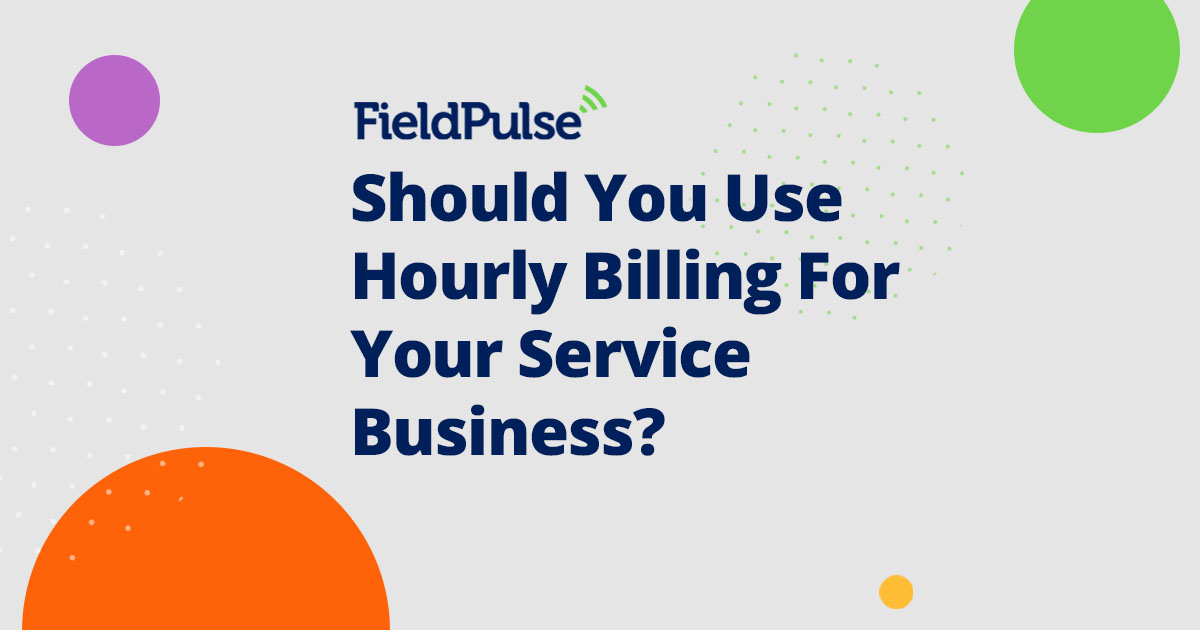How you structure your billing has a large impact on whether your customers consider you to be expensive or affordable. If the bill they get at the end of the day doesn’t match their expectations, it won’t matter how much it cost. Even when the final price is the same, customers assess value based on time and convenience, not just the dollar amount. If you’re still using an hourly billing model, you’re missing out on loads of customers. Pricing models have evolved, and it’s time to try something new. Here’s how hourly billing has been hurting your business:
Hourly Billing Looks Expensive
When you’re billing by the hour, you have the worst of both worlds: You have to cover your overhead costs with your hourly rate, and you have to include a line item for material costs. Customers interpret hourly rates as personal earnings, rather than as a rate that covers non-billable time and overhead expenses like administration and payroll, which can lead to uncomfortable confrontations over invoicing.Flat rate structures allow you to account for your overhead and your materials in one package deal, which is easier to market to potential customers. You can actually charge more for flat rate services while still appearing more affordable by removing time from the equation. When you focus on the time it takes to do the job, customers can feel slighted when projects take longer than expected. When you focus on the benefits provided by the service, everyone wins.
Hourly Billing Leads To Surprises
Most people aren’t good at mental math, and no one enjoys a surprisingly large invoice after a drawn-out project. Customers are less likely to pay on time when they’re confronted with an invoice that doesn’t match their expectations, and don’t always do the math when the hours start to add up.With a flat-rate approach, you have two options: provide a standard quote based on the average time it takes to complete the project, or provide a custom quote based on an on-site inspection. Either way, you’ll be able to meet your customer’s expectations come invoicing time, and enjoy a less painful collections process.
Hourly Billing Interferes With Rate Increases
Hourly billing doesn’t just look expensive, it also makes increasing your rates harder. When you tell your customers that your rates have increased since their last service call, they’ll try to run the math and perceive it as a massive personal earnings increase. They won’t look at cost of living adjustments or increased overhead expenses; they focus on the rate and compare it to their own.Flat rate billing, on the other hand, has the advantage of being perceived at the business level. It’s assumed to include overhead and material costs, and rate changes are easily marketed as business decisions instead of personal decisions. It adds an additional layer of professionalism.
Hourly Billing Lacks A Product
Customers want to buy services, not people. When they’re searching online or looking for recommendations, the closer they can get to a precise quote that matches their budget the more likely they are to schedule a service call. It’s hard to sell an hourly rate, as customers won’t instinctively know how long their project will take to fix.By treating your services like a product, you’ll be able to market it easily. You’ll be able to take advantage of online marketing tactics that your competitors can’t with hourly billing, and build a value-based pricing model without worrying about billable and non-billable hours.
Hourly Billing Doesn’t Encourage Productivity
When work is billed hourly, workers aren’t intrinsically encouraged to work efficiently. There’s a misalignment between customer and contractor goals with hourly billing, as the customer wants the most value for the price and the contractor wants the most time for the mental overhead. This can lead to friction and customer retention issues, because the motivations don’t match.With flat rate pricing, your values align with your customer values: You earn the most working quickly, and they get the most efficient work for the price. As long as your rate is high enough that you don’t cut corners, flat rate pricing can lead to increased productivity and better customer retention.
Hourly Billing Doesn’t Communicate Scope
Scoping a project is one of the most important parts of determining a valid price quote. With an hourly billing model, it’s easy to cut corners in non billable time, and miss important details. Since work capacity is always limited, this can lead to unmanageable or incomplete projects that reflect negatively on the business.With flat rate pricing, you can delineate common project sizes and pre-filter customers, reducing the time spent responding to bad leads. By increasing the quality of the customers coming in, you’ll reduce your business-related headaches and earn better feedback along the way.
Bill By The Project
Flat rate billing is perfect for situations where customers want a specific service, like satellite installations, common electrical work, and most jobs that require a strict price estimate. It’s an increasingly common model used by professionals across the globe, and it can have a huge impact on your business if you do it right.Most contractors and service businesses will employ a mixture of fixed rate and hourly billing practices (that’s unavoidable) but certain service types are more likely to be billed in certain ways. Here’s a quick breakdown on how to figure out a basic flat rate pricing scheme:
- Calculate how much time your common services typically take, and add a healthy margin of error.
- Add your typical per-project overhead for transportation costs, common material costs, and administrative costs.
- Add your margin.
The combined cost calculated here is the core of your flat rate price. There are more factors you can calculate, of course, but the basic math is based on time, overhead, opportunity, and margin. You can also account for liability, perceived value, taxes, and so on, but most of those details are specific to your business.Figuring out the specifics takes time, but it’s worth the investment. A flat rate model is healthier for your business, as it reflects the time, energy, and value you invest in the services you provide.


